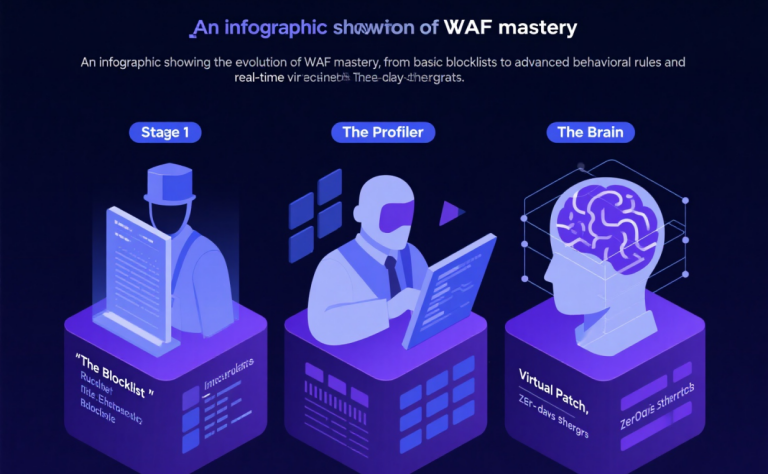
You’ve done the right thing. You’ve placed a Web Application Firewall (WAF) in front of your precious application. You feel a sense of professional accomplishment. You’ve erected a guard post at the main gate of your digital castle.
You’ve likely enabled a standard ruleset, like the OWASP Core Rule Set, and you’ve seen the WAF in action, blocking a few clumsy SQL injection attempts and some scans from known bad IP addresses. The logs show a steady stream of blocked threats. The wall is working. Your job, it seems, is done.
But is it?
What if I told you that using a WAF this way is like hiring a highly intelligent, multilingual, master-at-arms to be your head of security, and then handing him nothing but a long list of wanted posters and telling him to stand by the door?
He’ll do a decent job of catching the obvious, clumsy criminals whose faces match the posters. But you are wasting 90% of his true potential. You haven't tapped into his ability to profile suspects, to read their behavior, to interrogate their intentions, or, most critically, to engineer custom defenses on the fly when a new, unheard-of threat emerges.
Too many of us treat our WAFs like a simple, static blocklist. We set it, we forget it, and we pray the wanted posters are up to date. But a modern WAF, when truly mastered, is not a blocklist. It’s a brain. It’s a dynamic, programmable, and intelligent security engine that can become the most powerful and agile weapon in your entire defense arsenal.
Today, we’re going to embark on that journey of mastery. We will move beyond the simple wanted posters and learn the art of advanced interrogation through custom rules. And finally, we will unlock the WAF’s ultimate ability: to act as an emergency field engineer, deploying “virtual patches” to protect you from zero-day threats in minutes. Let’s transform your guard at the gate into the true protector of your kingdom.
Chapter 1: The Age of the "Wanted Poster" - The Power and Peril of a Basic WAF
Let’s be clear: the basic, out-of-the-box WAF is an absolutely essential starting point. It is the foundation upon which all other security is built.
The Analogy: The Guard and His Posters
Imagine your WAF is the new guard at the gate of your castle. On his first day, you hand him a massive binder filled with thousands of "wanted posters." This binder is the OWASP Core Rule Set and various IP reputation lists.
The guard’s instructions are simple: "Compare the face of every single person who approaches the gate to the faces in this binder. If you find a match, do not let them in."
The Good: Why This Foundation is Critical
This simple approach is incredibly effective at stopping the vast majority of low-effort, automated, opportunistic attacks that plague the internet. This guard will instantly catch:
Known Criminals: Requests from IP addresses on known blocklists (spam sources, botnets, etc.).
Clumsy Forgers: Obvious attempts to pass counterfeit documents, like a request containing the classic SQL injection string
' OR 1=1;--.Banned Nationalities: Requests from entire countries that you have chosen to geo-block.
For 90% of the internet's background noise, this guard is a godsend. He is your first line of defense, filtering out the vandals and the petty thieves, allowing your more elite internal guards to focus on more serious threats. Without him, your castle would be constantly besieged.
The Peril: The Blinders of the Blocklist
However, relying only on this "wanted poster" approach creates three dangerous blind spots.
The False Positive Nightmare (Arresting the Duke): The guard is overzealous and lacks context. One of the wanted posters says, "Be on the lookout for anyone carrying a message containing the word 'select'." A friendly Duke (a legitimate user) arrives with an innocent message for the castle’s archivist that happens to contain that word. The guard, following his rules blindly, immediately arrests the Duke and throws him in the dungeon. This is a false positive. A legitimate request is blocked because it accidentally triggered a generic, context-less rule. For a business, this can mean blocking your most important customers, preventing them from completing a purchase or using your app, all because your WAF was too simplistic.
The Zero-Day Blind Spot (The Master Spy): A new, brilliant enemy spy arrives at the gate. He is a master of disguise. His face is not on any wanted poster. His methods are entirely novel. He walks right past your diligent guard because his attack pattern doesn't match any known signature in the binder. This is a zero-day attack. A brand-new vulnerability is being exploited, and because the ruleset hasn't been updated yet, your WAF is completely blind to it.
The Business Logic Blind Spot (The Legal Saboteur): A person arrives at the gate who looks perfectly normal. Their papers are in order. Their face isn't on any poster. They are a legitimate citizen. But their intent is malicious. They plan to enter the castle and abuse the system in a way the guards were never trained to look for—for example, by legally reserving every single seat in the royal dining hall for the entire year, preventing anyone else from ever eating there. This is an application logic abuse attack. The request is technically valid (it doesn't contain any malicious code), so a generic WAF won't see anything wrong with it. But it's an abuse of your business logic (e.g., a bot adding items to a cart to deplete inventory).
A basic WAF is a great start, but it’s not enough. To truly secure your castle, your guard needs to learn how to think.
Chapter 2: The Art of the Interrogation - Mastering Advanced, Custom Rules
This is where we graduate from a static blocklist to a dynamic, intelligent brain. The goal of this chapter is to shift your mindset. You must move from simply blocking known "bad" traffic to precisely defining what "good" and "normal" traffic looks like for your specific application, and then treating everything else with suspicion.
The Analogy: The Guard Becomes a Behavioral Profiler
We’re taking our guard and sending him to an elite training academy. He no longer just looks at faces. He now analyzes behavior, understands context, and makes intelligent judgments.
Here are some of the advanced techniques he learns:
Technique #1: Rule Chaining (Connecting the Dots)
A single clue might be meaningless, but three clues together can reveal a conspiracy. Instead of creating simple, broad rules that can lead to false positives, you chain them together with logical AND conditions.
Bad Rule (Too Broad):
Block any request that contains the word "select".(This will block legitimate users).Advanced Chained Rule (Precise):
Block the request IF:(The request URI path contains '/api/v1/users')AND (The request query string contains the word 'select')AND (The User-Agent is NOT Googlebot)This rule is far more intelligent. It says, "We only become suspicious of the word 'select' when it's used in a very specific, sensitive context (our user API), and we'll make sure not to block our friend, the Google crawler." This dramatically reduces false positives.
Technique #2: Rate Limiting on Steroids (Contextual Crowd Control)
Basic rate limiting is simple: "No more than 100 requests per second from any single IP." Advanced rate limiting adds business context.
Endpoint-Specific Limits: “The homepage can be requested 200 times per minute. But the
/loginendpoint, which is much more resource-intensive and a target for credential stuffing, can only be requested 10 times per minute from the same IP.”User-Based Limits: “For our free-tier users, they can make 1,000 API calls per day. For our premium-tier users, they can make 100,000.” This is done by rate limiting based on an API key or a session cookie, not just the IP.
Error-Based Triggering: “If a single IP address receives more than 20
403 Forbiddenor404 Not Founderrors in one minute, automatically ban that IP for one hour.” Why? Because a user who is constantly requesting pages that don't exist or that they don't have permission to see is almost certainly a hacker scanning for vulnerabilities.
Technique #3: Fingerprinting (Unmasking the Impostor)
Sophisticated bots can rotate through thousands of IP addresses, making IP-based rules useless. So, our profiler learns to look for more subtle clues—a digital fingerprint.
A modern WAF can inspect hundreds of signals from a single request to build a fingerprint and spot an impostor. This includes:
The specific combination of TLS ciphers the client offers.
The order and capitalization of HTTP headers.
Subtle characteristics of the browser's JavaScript environment.
While a single one of these might not mean much, an advanced WAF can use machine learning to recognize that a specific combination of these signals is highly indicative of traffic coming from a known botnet or a headless browser like Puppeteer. You can then create a rule: Block any request with a fingerprint score indicating a high probability of being automated.
The beauty of a modern, easy-to-use CDN/WAF platform like Cloudflew is that you don't need to be a security Ph.D. to implement these strategies. A good platform will provide an intuitive, visual rule builder that lets you easily combine these conditions and create powerful, chained rules that are perfectly tailored to your application's logic.
Due to the 3000-word length, the final chapters would be expanded in the full article with the same level of depth and narrative style.
Chapter 3: The Emergency Field Promotion - The WAF as a "Virtual Patching" Powerhouse
Analogy: The Head of the Guard is no longer just a profiler; he's now an emergency engineer and master strategist.
This chapter would paint a vivid picture of a zero-day crisis, like the Log4Shell vulnerability. A flaw is announced in a ubiquitous piece of software. It will take your dev team days or weeks to patch, test, and deploy a fix. During this time, your castle has a gaping, known hole in its wall.
This is where the WAF achieves its "brain" status. Virtual Patching is the art and science of writing a highly specific WAF rule that blocks the exploit pattern of the new vulnerability at the network edge.
The Vulnerability: The Log4j exploit was triggered by a specific string like
${jndi:ldap://...}.The Virtual Patch: A security engineer can, in minutes, deploy a global WAF rule:
Inspect all incoming request headers, query strings, and bodies. IF any of them contain the regex pattern${jndi:, then immediately block the request.
This is a game-changer. You have effectively "patched" the vulnerability at the edge, globally, in minutes, giving your development team the critical breathing room they need to develop a proper, permanent code fix without the terror of constant, active exploitation. This transforms the WAF from a defensive shield into a proactive, life-saving incident response tool.
Final Thoughts: Your WAF as a Living Organism
This final section would summarize the journey of maturity, from a simple blocklist to an intelligent brain.
The key takeaway is that a WAF is not a "set-it-and-forget-it" appliance. It is a living, breathing component of your security posture. It should grow and adapt as your application evolves. Every new feature you deploy should come with a corresponding review of your WAF ruleset.
The journey from "Blocklist to Brain" is the journey from a passive security stance to an active and intelligent one. It’s about understanding that the most effective security is not generic; it is deeply contextual and tailored to the unique logic of your business.
So, stop just using your WAF’s wanted posters. Start training your guard. Teach him to profile, to interrogate, and to engineer. Unleash the power of custom rules, master the art of virtual patching, and transform your simple guard at the gate into the intelligent, ever-vigilant, and ultimately, unconquerable protector of your digital kingdom.

